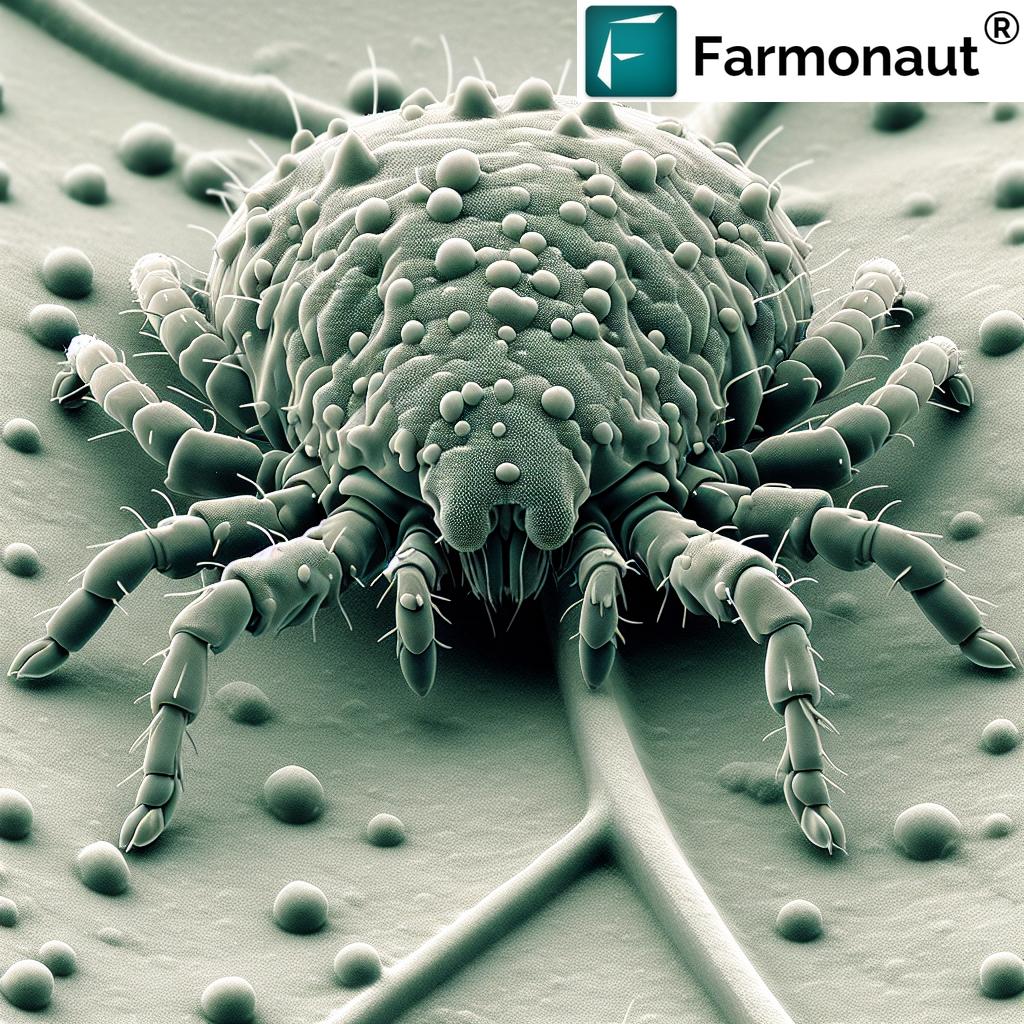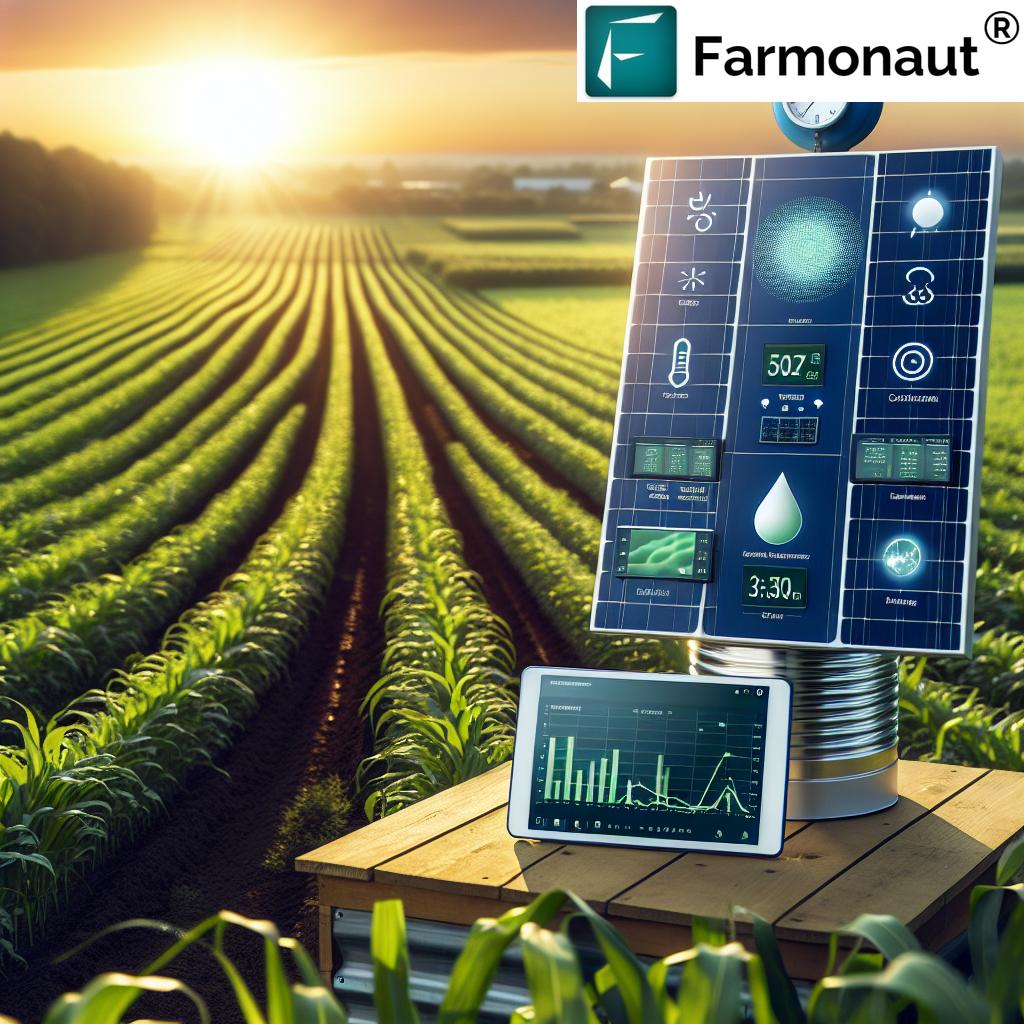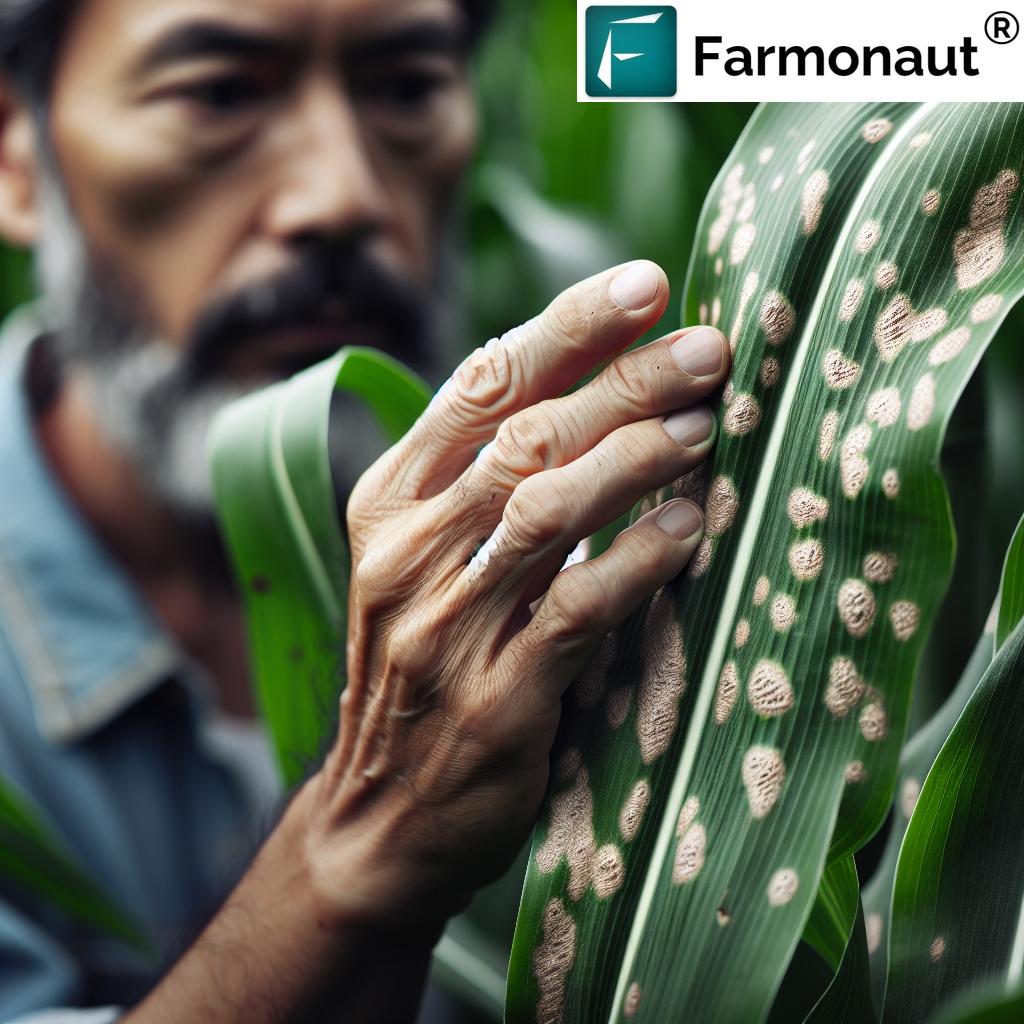Organic Mite Control: Protecting Your Crops from Microscopic Pests Without Chemicals

In the world of agriculture, we often face challenges that are invisible to the naked eye. Among these microscopic threats, mites stand out as a formidable foe for many farmers. These tiny arachnids can wreak havoc on a wide variety of crops, causing significant damage and yield losses if left unchecked. At Farmonaut, we understand the importance of protecting your crops while maintaining sustainable and environmentally friendly practices. That’s why we’re dedicated to providing innovative solutions for organic mite control, allowing farmers to safeguard their harvests without relying on harmful chemical pesticides.
Understanding Mites: The Microscopic Menace
Mites are minuscule arthropods, often less than 1mm in size, that belong to the class Arachnida. Despite their tiny stature, these pests can cause enormous problems for farmers across the globe. One particularly troublesome species is Polyphagotarsonemus latus, commonly known as the broad mite. This pest is notorious for its wide host range and the severe damage it can inflict on various crops.
Mites feed on plant tissues, primarily targeting the leaves and young, tender growth. As they feed, they inject toxic compounds into the plant, causing a range of symptoms that can be devastating to crop health and yield. Some of the crops most susceptible to mite infestations include:
- Eggplants
- Cucumbers
- Squash
- Watermelon
- Papaya
- Strawberry
- Cannabis
- Peppers
- Basil
- Grapes
- Citrus
- Tomatoes
- Potatoes
The Importance of Early Detection
One of the biggest challenges in mite control is their microscopic size, which makes early detection difficult. By the time visible symptoms appear, the infestation may already be severe. This is where advanced technology can make a significant difference. At Farmonaut, we’ve developed satellite-based crop monitoring systems that can detect early signs of stress in plants, potentially indicating mite infestations before they become visible to the naked eye.
| Detection Method | Accuracy | Speed | Coverage Area | Cost-Effectiveness |
|---|---|---|---|---|
| Traditional Visual Inspection | Moderate (depends on inspector’s experience) | Slow (time-consuming manual process) | Limited (labor-intensive for large areas) | Low (requires significant labor) |
| Farmonaut’s Satellite-Based Early Detection | High (detects subtle changes in plant health) | Fast (real-time monitoring) | Extensive (can cover large crop areas) | High (automated system reduces labor costs) |
As you can see from the comparison above, our satellite-based detection system offers significant advantages over traditional methods. By identifying potential mite infestations earlier, farmers can implement organic control measures more effectively, potentially saving entire crops from devastation.
Symptoms of Mite Infestation
While early detection through advanced technology is ideal, it’s also crucial for farmers to be aware of the visual symptoms of mite infestations. Some common signs include:
- Leaf distortion and curling
- Bronzing or silvering of leaves
- Stunted growth
- Reduced yield
- Fruit deformation
- Premature leaf drop
If you notice any of these symptoms in your crops, it’s important to take action quickly to prevent the infestation from spreading.
Organic Mite Control Strategies
At Farmonaut, we believe in the power of organic farming practices. While conventional pest control often relies heavily on chemical pesticides, organic methods focus on natural, sustainable solutions that protect both crops and the environment. Here are some effective organic strategies for mite control:
1. Biological Control
One of the most effective organic methods for mite control is the use of natural predators. Beneficial insects and mites can help keep pest populations in check without the need for chemical interventions. Some useful biological control agents include:
- Predatory mites (e.g., Phytoseiulus persimilis, Neoseiulus californicus)
- Ladybugs
- Lacewings
- Predatory thrips
These natural enemies can be introduced to your crops or encouraged through habitat management practices that provide food and shelter for beneficial insects.
2. Cultural Practices
Implementing good cultural practices can go a long way in preventing and managing mite infestations:
- Crop rotation: This practice helps break the pest lifecycle and reduces the buildup of mite populations.
- Proper irrigation: Avoid over-watering, as mites thrive in humid conditions.
- Adequate plant spacing: Proper spacing improves air circulation, making the environment less favorable for mites.
- Removal of infested plant material: Promptly remove and destroy heavily infested plants to prevent the spread of mites.
- Weed management: Keep areas around crops free of weeds, which can harbor mites.
3. Physical Barriers
Creating physical barriers can help protect your crops from mite infestations:
- Row covers: Use fine mesh covers to prevent mites from accessing plants.
- Sticky traps: While not effective for control, these can help monitor mite populations.
4. Organic Pesticides
When other methods aren’t sufficient, certain organic pesticides can be used as a last resort. These include:
- Neem oil
- Insecticidal soaps
- Sulfur-based products (for certain mite species)
- Pyrethrin (derived from chrysanthemum flowers)
It’s important to note that even organic pesticides should be used judiciously, as they can also affect beneficial insects if not applied correctly.
The Role of Technology in Organic Mite Control
At Farmonaut, we’re passionate about leveraging technology to enhance organic farming practices. Our satellite-based crop monitoring system can play a crucial role in mite management by:
- Detecting early signs of plant stress that may indicate mite infestations
- Monitoring the effectiveness of control measures
- Providing data-driven insights for precision application of organic treatments
- Tracking environmental conditions that may favor mite outbreaks
By combining these technological advancements with traditional organic farming methods, we can create a more robust and effective approach to mite control.

Case Studies: Successful Organic Mite Control
While we don’t include specific case studies or success stories, it’s worth noting that many farmers around the world have successfully implemented organic mite control strategies. These approaches have been particularly effective in greenhouse environments, where conditions can be more closely managed, and in integrated pest management (IPM) systems that combine multiple control methods.
The Future of Organic Mite Control
As we look to the future, we at Farmonaut are excited about the potential for even more advanced organic mite control strategies. Some areas of ongoing research and development include:
- Improved biological control agents: Scientists are continually discovering and developing new predatory mites and insects that can more effectively control pest populations.
- Plant breeding for resistance: Developing crop varieties with natural resistance to mites can reduce the need for interventions.
- Advanced monitoring technologies: Improvements in satellite imaging, drone technology, and AI-powered analysis will enable even earlier detection and more precise management of mite infestations.
- Novel organic compounds: Research into plant-derived substances may lead to new, effective organic pesticides.
Implementing Organic Mite Control on Your Farm
If you’re considering implementing organic mite control strategies on your farm, here are some steps to get started:
- Assess your current situation: Identify the mite species affecting your crops and evaluate the extent of the infestation.
- Develop an integrated management plan: Combine multiple control strategies for the best results.
- Implement preventive measures: Focus on cultural practices that create an environment less favorable to mites.
- Monitor regularly: Use both visual inspections and technology-assisted monitoring to catch infestations early.
- Introduce biological controls: Release predatory insects or mites as a proactive measure.
- Use organic treatments judiciously: Apply organic pesticides only when necessary and according to label instructions.
- Evaluate and adjust: Regularly assess the effectiveness of your control measures and make adjustments as needed.
Remember, successful organic mite control is an ongoing process that requires vigilance and adaptability. By staying informed about the latest research and technologies, you can continue to improve your management strategies over time.
How Farmonaut Can Help
At Farmonaut, we’re committed to supporting farmers in their transition to more sustainable and organic farming practices. Our satellite-based crop monitoring system can be a valuable tool in your organic mite control efforts. By providing early detection of plant stress and detailed insights into crop health, we can help you make informed decisions about when and where to implement control measures.
To learn more about how our technology can support your organic farming practices, visit our website or try our app:
For developers interested in integrating our satellite and weather data into their own systems, check out our API documentation:
Conclusion
Organic mite control is a critical aspect of sustainable agriculture, allowing farmers to protect their crops without relying on harmful chemical pesticides. By combining traditional organic farming practices with cutting-edge technology, we can create more effective and environmentally friendly pest management strategies.
At Farmonaut, we’re proud to be at the forefront of this agricultural revolution, providing farmers with the tools they need to implement successful organic mite control programs. Together, we can work towards a future where healthy crops and a healthy environment go hand in hand.
FAQs
Q: What are the most common mite species that affect crops?
A: Some of the most common mite species that affect crops include spider mites (Tetranychus species), broad mites (Polyphagotarsonemus latus), and russet mites (Aculops lycopersici). Each species can affect different crops and may require specific control strategies.
Q: How can I tell if my crops are infested with mites?
A: Common signs of mite infestation include leaf distortion, bronzing or silvering of leaves, stunted growth, and reduced yield. You may also see tiny specks moving on the undersides of leaves when using a magnifying glass.
Q: Are organic mite control methods as effective as chemical pesticides?
A: When implemented correctly, organic mite control methods can be just as effective as chemical pesticides. While they may take longer to show results, organic methods are often more sustainable in the long term and don’t carry the risk of pesticide resistance.
Q: How often should I monitor my crops for mite infestations?
A: Regular monitoring is crucial for effective mite control. We recommend checking your crops at least weekly during the growing season, and more frequently during hot, dry periods when mite populations tend to increase rapidly.
Q: Can Farmonaut’s technology detect mite infestations before they become visible?
A: While our satellite-based system can’t directly detect mites, it can identify early signs of plant stress that may indicate a mite infestation. This early warning can allow farmers to investigate and implement control measures before the infestation becomes severe.
Q: Are there any crops that are naturally resistant to mites?
A: While no crop is completely immune to mites, some varieties have been bred for increased resistance. For example, certain tomato varieties show resistance to russet mites. It’s best to consult with local agricultural extension services for information on resistant varieties suitable for your area.
Q: How can I encourage natural predators of mites in my fields?
A: You can encourage natural predators by providing habitat diversity, such as planting flowering strips or hedgerows near your crops. Avoiding broad-spectrum pesticides, even organic ones, can also help preserve beneficial insect populations.
Q: Is it possible to completely eradicate mites from my crops?
A: Complete eradication of mites is rarely possible or necessary. The goal of organic mite control is to keep mite populations below economically damaging levels while maintaining a balance of beneficial organisms in your agroecosystem.
Q: How do weather conditions affect mite populations?
A: Mites generally thrive in hot, dry conditions. High temperatures can accelerate their life cycle, leading to rapid population growth. Conversely, heavy rainfall can help suppress mite populations by physically washing them off plants.
Q: Can I use Farmonaut’s technology for other aspects of crop management besides pest control?
A: Absolutely! Our satellite-based monitoring system can provide valuable insights for various aspects of crop management, including irrigation scheduling, nutrient management, and yield estimation. Visit our website or try our app to explore all the features we offer.













